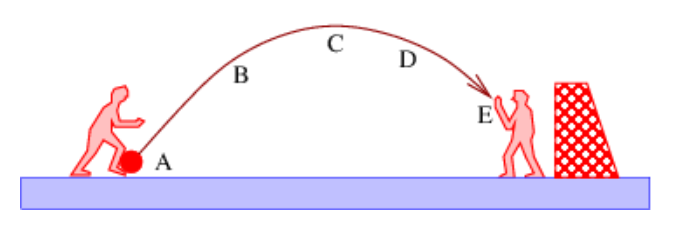8.8: Problems
( \newcommand{\kernel}{\mathrm{null}\,}\)
- Suppose the dispersion relation for a matter wave under certain conditions is ω=μ+(k−a)2c2/(2μ) where k is the wavenumber of the wave, μ=mc2/ℏ, m is the associated particle’s mass, a is a constant, c is the speed of light, and ℏ is Planck’s constant divided by 2Π.
- Use this disperson relation and the Planck and de Broglie relations to determine the relationship between energy E, momentum Π, and mass m.
- Compute the group velocity of the wave and use this to determine how the group velocity depends on mass and momentum in this case.
- A matter wave function associated with a particle of definite (constant) total energy E takes the form shown in Figure 8.8.5:. Make a sketch showing how the kinetic, potential, and total energies of the particle vary with x.
 Figure 8.8.5:: A wave function in which the wavelength varies with position.
Figure 8.8.5:: A wave function in which the wavelength varies with position. - Compute ∂/∂x and ∂/∂y of the following functions. Other symbols are constants.
- f(x,y)=ax2+by3
- f(x,y)=ax2y2
- f(x,y)=(x+a)(y+b)
- Given a potential energy for a particle of mass M of the form U(x)=Ax3−Bx where A and B are positive constants:
- Find the force on the particle.
- Find the values of x where the force is zero.
- Sketch U(x) versus x and graphically compare the slope of U(x) to the force computed above. Do the two qualitatively match?
- If the total energy of the particle is zero, where are its turning points?
- What is the particle’s speed as a function of position assuming that the total energy E is known?
- Given a potential energy function U(x,y)=A(x2+y2) where A is a positive constant:
- Sketch lines of constant U in the x-y plane.
- Compute the components of force as a function of x and y and draw sample force vectors in the x-y plane on the same plot used above. Do the force vectors point “uphill” or “downhill”?
- Do the same as in the previous question for the potential energy function U(x,y)=Axy
- Suppose that the components of the force vector in the x-y plane are F=(2Axy3,3Ax2y2) where A is a constant. See if you can find a potential energy function U(x,y) which gives rise to this force.
- You are standing on top of a cliff of height H with a rock of mass M.
- If you throw the rock horizontally outward at speed u0, what will its speed be when it hits the ground below?
- If you throw the rock upward at 45∘ to the horizontal at speed u 0, what will its speed be when it hits the ground? Hint: Can you use conservation of energy to solve this problem? Ignore air friction.
- A car of mass 1200 kg initially moving 30 m s−1 brakes to a stop.
- What is the net work done on the car due to all the forces acting on it during the indicated period?
- Describe the motion of the car relative to an inertial reference frame initially moving with the car.
- In the above reference frame, what is the net work done on the car during the indicated period?Is work a relativistically invariant quantity?
 Figure 8.8.6:: The trajectory of a soccer ball.
Figure 8.8.6:: The trajectory of a soccer ball.
- A soccer player kicks a soccer ball, which is caught by the goal keeper as shown in Figure 8.8.6:. At various points forces exerted by gravity, air friction, the foot of the offensive player, and the hands of the goal keeper act on the ball.
- List the forces acting on the soccer ball at each of the points A, B, C, D, and E.
- State whether the instantaneous power being applied to the soccer ball due to each of the forces listed above is positive, negative, or zero at each of the labeled points.
- A cannon located at (x,z)=(0,0) shoots a cannon ball upward at an angle of θ from the horizontal at initial speed u0. Hint: In order to solve this problem you must first obtain the x and z components of acceleration from Newton’s second law. Second, you must find the velocity components as a function of time from the components of acceleration. Third, you must find x and z as a function of time from the the components of velocity. Only then should you attempt to answer the questions below.
- How long does it take the cannon ball to reach its peak altitude?
- How high does the cannon ball go?
- At what value of x does the cannon ball hit the ground (z = 0)?
- Determine what value of θ yields the maximum range.


